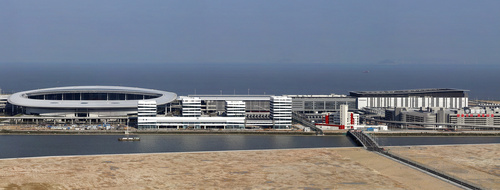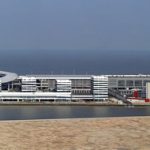 The Macao boundary crossing area of the Hong Kong-Zhuhai-Macao Bridge is governed by laws of the Macao SAR.
The Macao boundary crossing area of the Hong Kong-Zhuhai-Macao Bridge is governed by laws of the Macao SAR.
The Chief Executive, Mr Chui Sai On, has authorised the use by the Macao Special Administrative Region (SAR) of the Macao boundary crossing area of the Hong Kong-Zhuhai-Macao (HKZM) Bridge. The authorisation took effect on the stroke of midnight today (Thursday).
Such permission was announced in Chief Executive Notice No. 13/2018 published today in the Macao SAR Gazette.
The State Council had earlier approved Macao’s jurisdiction over the Hong Kong-Zhuhai-Macao Bridge boundary crossing area serving Macao. As of midnight today, the relevant area is governed by the laws of the Macao SAR.
The artificial island on which stands the Macao boundary crossing area also houses facilities for a boundary crossing area serving Zhuhai.
The Macao boundary crossing area is an important part of the Hong Kong-Zhuhai-Macao Bridge and a significant project for the Macao SAR Government. The facilities are a crucial piece of infrastructure in order for Macao to take part in the “Belt and Road” initiative and the development of the Guangdong-Hong Kong-Macao Greater Bay Area.
Ministries and departments of the Central Government, and departments of, respectively, the Guangdong Provincial Government and the Zhuhai Prefectural Government, have offered great support and assistance to Macao during the construction process.
Construction of the Macao boundary crossing area facilities commenced in December 2016 and fundamentals of the project were completed in December 2017. A lighting ceremony was held on 18 December 2017 to mark the milestone.
The boundary crossing area serving Macao covers 71.6 hectares and has structures with a total gross floor area of 600,000 square metres. There is a building for customs clearance, and two public car parks. The latter are located respectively at the east and west end of the artificial island – with a total of 6,800 spaces for private vehicles and another 2,000 for motorcycles.
Facilities at the Macao boundary crossing area also comprise: 53 buildings – about 40,000 square metres of gross floor area – for municipal use; and about 200,000 square metres of space dedicated to infrastructure including road network, tunnels, flyovers, railway platforms and municipal facilities.


